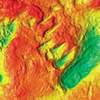Footprints lead BU to research prize shortlist
 |
Ground-breaking work in conservation sciences leads BU academics to shortlist for major prize |
The work of BU Professor Matthew Bennett in developing a better understanding of our ancestors through the analysis of early human footprints in Kenya has led to a nomination for ‘Research Project of the Year’.
Professor Bennett and his colleagues from BU’s School of Conservation Sciences have been named as finalists for the prestigious prize to be announced during the 2009 Times Higher Education (THE) Awards in October.
Working with colleagues from the US and Africa, Professor Bennett travelled to Ileret in northern Kenya to scan footprints left by one of our evolutionary ancestors, Homo erectus. The footprints, dating from 1.51 to 1.53 million years ago, reveal a modern foot anatomy and function with evidence that whoever left them walked much like we do today.
Professor Bennett used an optical laser scanner to capture the morphology of the prints to within a fraction of a millimetre. The scanner is mounted on a custom built frame that was designed and built at BU by its School of Design, Engineering and Computing.
The morphology data obtained from the scans allowed Professor Bennett statistically to compare these prints with others discovered and recorded over the last two years revealing new evidence of early human development.
A research paper on the footprint analysis, led by Professor Bennett, received international attention in February after featuring in Science - one of the world’s leading journals. The paper, a landmark first by a BU academic, was accompanied by Professor Bennett’s colourful laser scan of footprints from the site, featured on the cover of Science, another first for BU.
In July, Professor Bennett returned to Africa to join an international team from Rutgers and George Washington Universities, working in collaboration with the National Museum of Kenya.
The team excavated another 28 square metres of footprint surface dated to 1.4 million years ago to the south of Koobi Fora in Area 103 some 45 kilometres south of the main footprint site featured in the original Science paper.
“This surface was rich in animal prints left on the margins of a former lake and contains several new hominin prints adding significantly to the research programme first reported in February,” said Professor Bennett. “There is the intriguing possibility that a different hominin species made the new prints which needs further investigation.”
Recently, Professor Bennett submitted a research bid to the National Environment Research Council (NERC) in collaboration with Professor Robin Crompton of Liverpool University for over £800k to continue this research and uncover further information about the evolution of human gait in our ancestors.
10/09/09
